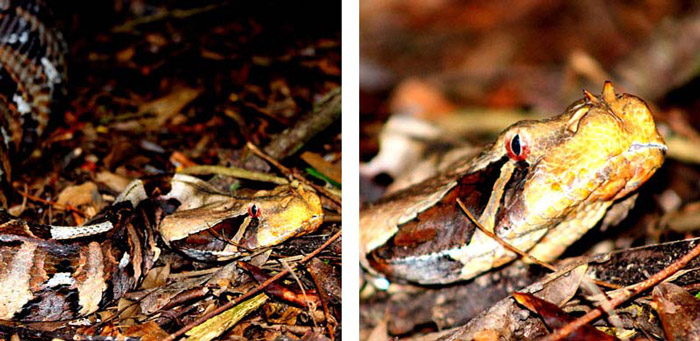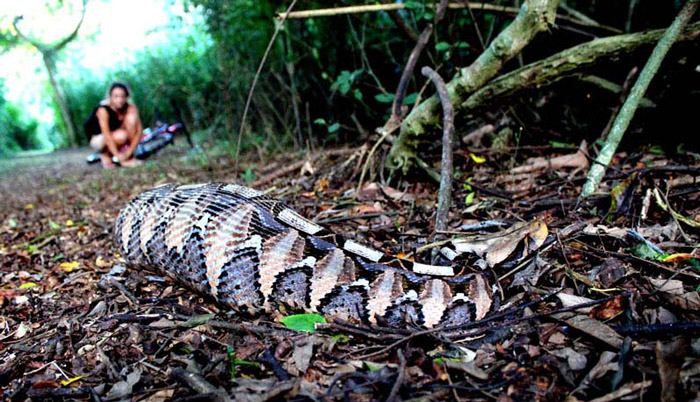Of the 36 recorded snake species known to occur in iSimangaliso Wetland Park, the beautiful Gaboon adder (Bitis gabonica) is surely the most iconic.


The Gaboon adder is a sedentary species renowned for its striking geometric patterning – and is the world’s heaviest adder. Stocky and often obese, the species can attain lengths up to 2 metres, although in iSimangaliso, individuals rarely exceed 1.3 metres. The disproportionately large head resembles a dead leaf with a dark dorsal stripe that mimics a midvein. Among snakes, Gaboon adders have the longest fangs (max. 40mm) and the highest venom yields. Bites from Gaboon adders are medical emergencies, but the species is of docile disposition, and most bites occur from the handling of captive individuals by snake enthusiasts. Envenomation incurs mostly cytotoxic symptoms, although toxic effects on humans are not well known, and only one human death is described in the literature.
This extremely rare inhabitant recently had its numbers boosted by 26 following the release of neonates at three locations on the Eastern Shores of iSimangaliso. Born in captivity at the iSimangaliso St Lucia Crocodile and Education Centre, their release into the wild was in line with the release protocol suggested by a three-year study (2005-2007) by registered researcher Jon Warner who recently completed his Master of Science thesis on the conservation biology of the species in South Africa.
According to the park CEO Andrew Zaloumis, “Jon’s Gaboon research was one of the 185 current registered research projects ongoing in the World Heritage Site. iSimangaliso encourages research in numerous fields to inform and improve our management strategies and contribute to the creation of scientific knowledge. Jon’s finding points to the importance of maintaining the continuity and integrity of the entire iSimangaliso dune forest corridor to protect and conserve the Gaboon adder. This is a good example of how iSimangaliso conserves high conservation value species by protecting their habitats.”


Although primarily a tropical species extending into equatorial Africa, their distribution is very restricted in South Africa and is mainly confined to iSimangaliso, highlighting the park’s importance for the future conservation of the South African population.

Following the insertion of tracking devices in the belly of selected Gaboon adders, Jon could track and monitor their movements as part of his research.
The core activity area averaged 6.7 hectares, with the mean male core activity centre almost five times greater than that of females. Snakes tracked (using VHF telemetry) were highly sedentary, especially during winter when individuals remained at single localities for extended periods (max. 87 days). Activity peaked for both sexes at the onset of the breeding season during March, with individuals averaging a movement distance of 598 metres.
The Gaboon adder is a terrestrial forest Adderid, and its habitat preferences in iSimangaliso are strongly influenced by season, with individuals selecting open-canopied areas during cooler months. This behaviour is presumably because the forested habitat individuals utilise for the rest of the year is inadequate for the species’ thermoregulatory requirements during winter. Females used slightly less shrubby microhabitats than males, and “thicket” microhabitat is important for the protection, thermoregulation and food acquisition requirements of Gaboon adders in iSimangaliso.
The feeding activity of Gaboon adders varied between seasons, with individuals spending long periods at single localities in an ambush position, especially during summer. Snakes exhibited strong ambush site fidelity, often remaining immobile for weeks at a time. Sites where ambush behaviour was observed were frequently in proximity (less than 1 metre) to game trails created by antelope. Gaboon adders may feed on prey as large as Red duiker (Cephalophus natalensis).

Ecological research from Jon’s study, coupled with new molecular data showing that South African and central African Gaboon adders are genetically similar, suggests the South African Gaboon adder population’s conservation status is better than previously assumed. However, long-term protection and management of the coastal dune forest corridor (found primarily inside iSimangaliso) is needed for a viable, local Gaboon adder population.

Visitors walking the self-guided trails in the Igwalagwala Trail and St Lucia Nature Park areas of iSimangaliso should keep a careful eye open for these snakes as they are fond of lying in a sunny patch of the path or amongst fallen leaves. Several visitors have reported spotting Gaboons, wisely choosing to leave a wide berth between themselves and the snoozing snake. A sighting should be considered a rare and special privilege and just another example of the miracles awaiting discovery in iSimangaliso.
To comment on this story: Login (or sign up) to our app here - it's a troll-free safe place 🙂.![]()






